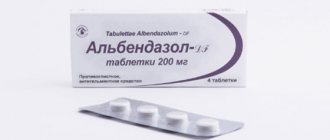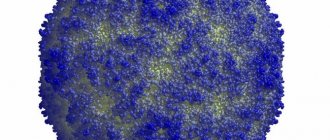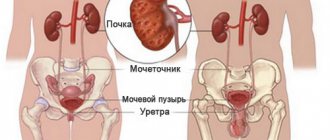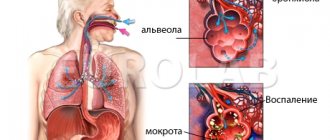Symptoms of HIV in men may not appear immediately. HIV is a virus that attacks the immune system, specifically CD4 cells. CD4 cells help protect the body from disease; in simple terms, these are the cells responsible for human immunity. Unlike other viruses, which the immune system can fight off normally, HIV cannot be cured by the immune system. Moreover, the immune system in men perceives these cells as their own and does not take measures to combat the symptoms of HIV.
When do the first signs appear?
When infected, as well as during the intensive development of the infection, a person has no obvious signs. Once a pathogen enters the bloodstream, the immune system tries to protect the body. In the period from the first three weeks to three months, signs of nonspecific symptoms may appear: chills, fever, cough, swollen lymph nodes. Rarely, these symptoms are accompanied by a skin rash. Such manifestations are very similar to a respiratory disease or allergy, so those infected often do not attach importance to these symptoms.
Content:
- When do the first signs appear?
- Main symptoms
- Signs at different stages
- Primary symptoms
- Secondary signs
- Generalized lymphadenopathy
- Manifestations of CNS damage
- What does an HIV-infected person look like?
- Symptoms in women
- Features of infection in men
- Children with HIV
- How to determine the immunodeficiency virus at home
Often the virus does not manifest itself at all for many years. On average, the first signs appear in the range from 3 months to 5 years after infection. And antibodies to the pathogen are detected 6-12 months after infection. Therefore, the main way to detect the presence of the virus is testing, which can be done free of charge.
What is AIDS?
AIDS
- This is acquired immunodeficiency syndrome. This is not a disease, but a syndrome manifested by a variety of diseases that can lead to death.
AIDS is caused by the human immunodeficiency virus (HIV). It belongs to viruses that have their own RNA, to the genus Retroviruses, family Lentiviruses. Scientists distinguish between HIV-1 and HIV-2. It is HIV-1 that leads to the epidemic, while HIV-2 is rare, most often among the population of West Africa. Having penetrated the human body, the virus searches for CD4 cell receptors, attaching to which it penetrates the cell.
Inside the cell, the RNA of the virus synthesizes DNA on itself, it penetrates into the host’s nucleus and exists with it until the cell dies. Viral DNA reproduces RNA for new viruses. They, in turn, infect new cells. CD4 receptors are located in nervous and immune tissue, so it is these systems that the virus attacks first.
HIV-1 can only be spread by sick people. There is speculation that this virus may infect chimpanzees.
In addition to humans, HIV-2 can exist in the body of some African monkeys. In the external environment, the virus quickly dies; it does not tolerate dryness and heat. Almost all antiseptics lead to its instant destruction.
An infected person has the virus in all fluids, including tears, milk, spinal fluid, saliva, etc. Most viruses are found in blood, vaginal secretions and semen.
Main symptoms
Typical signs of HIV infection are a set of symptoms of secondary diseases, that is, those diseases that a weakened immune system is not able to fight. Classic manifestations include symptoms of fungal infection of the mucous membranes, aphthous stomatitis, polylymphoadenopathy, various manifestations of herpes virus infection, Pneumocystis pneumonia, infiltrative tuberculosis, digestive disorders, rashes, central nervous system damage and others. Along with them, symptoms of infection appear that resemble a respiratory disease. The main sign by which HIV can be suspected is generalized lymphadenopathy and pancytopenia.
You should be alert to the appearance of episodes of fever, diarrhea, and damage to the mucous membranes. The further the infection progresses, the greater the range of symptoms there may be.
The source of trouble is a virus
The immunodeficiency virus was discovered in 1982, by which time there were already thousands of AIDS patients. Three years later, its sibling was discovered, differing only in the structure of the surface shell; the clinical picture of the disease they cause is not at all different, therefore both viruses are named type1 and type2. Lentiviruses, a group of which includes HIV, live in animal bodies for millions of years, suggesting that the very first HIV came to humans from a monkey about a hundred years ago, and this happened somewhere in West Africa.
No one knows who actually was the first or even the thousandth infected, because the infection was discovered when it had already formed an epidemic, when the patients were already in the last stage of the disease, to which years and years had passed. This is the first infection that was so belatedly revealed to humanity. The reason for this is the peculiarity of the course, when there are no symptoms of the disease for many years. As if trying to make up for lost time, scientists have developed HIV into the most studied viruses, writing hundreds of thousands of articles about it.
Signs at different stages
The infection develops in stages. As the number of viral particles increases, more and more cells of the immune system are involved in the process, an adequate immune response is blocked, and inflammatory, autoimmune and oncological changes develop. The use of antiretroviral therapy slows down the progression of the disease, prolonging the life of patients. The HIV clinic at different stages has its own characteristics. Symptoms are varied and gradually increase with a decrease in the number of active immune cells.
Incubation period
According to the classification of V.V. Pokrovsky, the first stage of infection is called incubation. This is the period of time from the pathogen entering the body until the appearance of antibodies in the blood or primary symptoms. On average, this stage lasts 3-12 weeks. As a rule, there are no obvious symptoms. The person looks healthy and feels good. In rare cases, symptoms of ARVI are possible. Tests for HIV infection during this period are negative, so you need to repeat the examination after 3 and 6 months. Once antibodies appear, symptoms may also not be observed for many years. When antibodies are already present in the blood, and there are no manifestations of infection, the next stage begins - latent.
Asymptomatic period
This is the longest phase of the disease; a person can be a carrier of the pathogen for 5-15 years. If the patient leads a healthy lifestyle, the asymptomatic period may last even longer. In patients with bad habits and a low standard of living, the latent course quickly passes into the acute phase.
Also, the duration of incubation and asymptomatic course depends on:
- patient's age;
- infectious dose;
- immune status of the patient;
- routes of infection.
For example, with a blood transfusion, incubation and the asymptomatic period pass faster than with sexually transmitted infection. The virus continues to multiply during the latent phase, but the immune system is still able to suppress infections. The virus does not manifest itself clinically and can only be determined through laboratory testing.
Terminal stage of HIV infection
The transition to the terminal stage of AIDS in men and women occurs when the level of CD4 lymphocytes decreases to 50 or below per 1 μl. During this period, an uncontrollable course of the disease is observed and an unfavorable outcome is expected in the near future. The patient is exhausted, depressed and loses faith in recovery.
The lower the level of CD4 lymphocytes, the more severe the manifestations of infections and the shorter the duration of the terminal stage of HIV infection.
Signs and symptoms of end-stage HIV infection
- The patient develops atypical mycobacteriosis, CMV (cytomegalovirus) retinitis, cryptococcal meningitis, widespread aspergillosis, disseminated histoplasmosis, coccidioidomycosis and bartonnellosis, and leukoencephalitis progresses.
- Symptoms of diseases overlap each other. The patient's body quickly becomes exhausted. Due to constant fever, severe symptoms of intoxication and cachexia, the patient is constantly in bed. Diarrhea and loss of appetite leads to weight loss. Dementia develops.
- Viremia increases, CD4 lymphocyte counts reach critically minimal values.
Rice. 17. Terminal stage of the disease. Complete loss of the patient's faith in recovery. In the photo on the left is an AIDS patient with severe somatic pathology, in the photo on the right is a patient with a common form of Kaposi's sarcoma.
Primary symptoms
The third stage is divided into three distinct phases: acute, asymptomatic and generalized lymphadenopathy. In the first phase, obvious signs of the disease appear. Most often, it is during this period that the patient may suspect an infection and undergo testing.
Phases of primary symptoms:
- Acute phase. After the latent period, a sharp release of viruses into the bloodstream occurs. The spread of the pathogen throughout the body causes a number of symptoms. During this period, several bacterial and fungal diseases usually appear at once. The main signs of which are: fever, muscle and joint pain, diarrhea, swollen lymph nodes, rash. The most specific and frequent manifestations during this period are thrush in the mouth, weight loss, and weakness. The acute phase in some patients occurs in a mild form, while in others a severe course develops. In case of a complicated form, patients are hospitalized. However, even without therapy, this phase passes within 2-4 weeks. After this, the asymptomatic period begins again.
- Asymptomatic phase. After a sharp attack on the immune system, a balance occurs between viral agents and the body’s defenses. Multiple replication of the virus is contained. At this time, the pathogen is still multiplying, and the number of T-helper cells is falling, but at a very slow pace. This stage can last from 1 month to 10 years, depending on many factors. The patient feels well at this time, there are no external signs of the disease. But it can transmit the pathogen sexually, through blood, or from woman to child during pregnancy.
The use of antiretroviral therapy during the asymptomatic stage prolongs the latent course for many decades. At the same time, the patient lives a full life, subject to the rules of a healthy lifestyle and treatment. In addition, the use of ART makes transmission of infection more difficult.
AIDS treatment
Today there is no way to completely cure a person from AIDS. There is also no vaccine developed that would prevent infection. At the same time, scientists have created effective antiretroviral drugs that can relieve the load of the virus on the body. This prevents HIV from progressing to the AIDS stage. Treatment is prescribed to the patient for the rest of his life.
In order for the drugs to achieve the desired effect, they will need to be taken in combination. They all have a different mechanism of action. The effectiveness of ART has been proven by 2 major studies: HPTN-052 and CPOI-2014. Homosexuals took part in them. In this case, one of the partners was infected (he took drugs), and the other was healthy.
In 2005, the HPTN-052 study was initiated. By 2011, the likelihood of infection had decreased by 96%.
In 2011, the CRIO-2014 study was launched. It was carried out only in America. At the same time, 40% of couples were tracked, of which 280,000 were heterosexual and 164,000 were homosexual unprotected contacts. As of February 2014, no cases of transmission have been reported.
Although research is still ongoing, the results are already very impressive.
Secondary signs
Based on secondary manifestations of infection, doctors may suspect HIV. However, even these manifestations can initially be considered as an independent disease.
Testing for the immunodeficiency virus is mandatory for the following secondary symptoms:
- Pneumonia. The patient develops a dry, prolonged cough and low-grade fever (the temperature rise is no higher than 38°C for a long time). Over time, the cough turns into a wet one, you feel a general malaise, weakness, and sweating. The use of classical antibiotics does not give a positive result.
- Generalized infections are a combination of bacterial, fungal and viral diseases. Most often, these include: tuberculosis, oral, genital and visceral candidiasis, cytomegalovirus and EBV infections, common and herpes zoster, viral gastroenteritis. Against the background of immunodeficiency, these diseases are especially difficult.
- Kaposi's sarcoma is a neoplasm in the lymphatic system. It looks like a single tumor or a cluster of formations, and is most often localized on the torso, neck, mouth and head. Sometimes sarcoma has a cherry tint to the skin, but it can also be without any color change.
- Intoxication syndrome. About half of the patients experience the following symptoms: nausea, muscle and joint pain, diarrhea, night sweats, severe weakness, headache, increased irritability.
In addition to these symptoms, the patient sometimes experiences worsening chronic diseases. Secondary diseases and symptoms can occur one after another or together. The moment of onset and duration depend on the adequacy of therapy, the age of the patient, bad habits and other factors. On average, each symptom lasts 1-2 weeks. Cough and diarrhea may not go away for 1-2 months.
Preventing your health from HIV
According to a CDC analysis, in the Russian Federation, 1 out of 8 people living with the HIV virus do not know that they are carriers of the disease. A slight increase in people infected with this virus against the general background indicates the stability of this disease. The fight against this disease cannot be done in one place. Only proper prevention of this disease will not lead to dire consequences, but will also not allow it to spread further.
It is extremely important that you monitor your health; as soon as symptoms indicating HIV disease appear, you should immediately undergo examination at a medical facility. You should also take steps to prevent HIV infection by avoiding contact with potentially infectious body fluids.
You can reduce your risk of contracting HIV by taking preventative measures:
- Practice safe sex: Use a condom during vaginal and anal sex. Currently, this is a fairly effective way to protect against HIV;
- Avoid reusing syringe needles: Never share or reuse needles. Many cities have needle exchange programs that provide sterile needles.
- Take precautions: Always assume that blood may be infectious. Protect yourself by using latex gloves and other barriers.
- Get tested for HIV: Getting tested is the only way to know if you have HIV. If you test positive for HIV, you can get treatment and take steps to reduce the risk of spreading the virus to others.
Generalized lymphadenopathy
Generalized lymphadenopathy – enlargement of all groups of lymph nodes. This symptom appears most often during the stage of acute infection. It can be combined with other signs, or it can be independent. Lymph nodes enlarge in various diseases, so a patient who does not know his HIV status often does not attach importance to this.
A distinctive feature of generalized lymphadenopathy is its long course. The symptom lasts 1-3 months, pain does not always occur. More often, the lymph nodes increase to a diameter of 1.5-2 cm. They are localized one or more on the neck, behind the ears, in the armpits and subclavian cavities, and in the groin. The formations are mobile, soft, sometimes they decrease, sometimes they increase.
Together with lymphadenopathy, the patient may experience:
- seborrhea;
- leukoplakia of the tongue;
- herpes simplex on mucous membranes and skin;
- polymorphic rashes;
- thrush of the oral cavity and genitals.
Symptomatic treatment during this period gives good results. Secondary diseases are treatable. With proper treatment, the patient feels satisfactory, can work, play sports, and have protected sex. The duration of this phase ranges from six months to 5 years. Although, depending on the patient’s lifestyle and the availability of treatment, this period can be either shortened or extended.
Etiology
The source of HIV can be a virus carrier who does not show symptoms of the disease, or a sick person.
Routes of HIV transmission:
- sexual transmission. HIV can be transmitted to a healthy person through sexual contact. The greatest danger is posed by anal and vaginal sex;
- perinatal route. In this case, the child becomes infected from the sick mother. A newborn can become infected while passing through a woman’s birth canal;
- blood transfusion route of transmission. Infection occurs during transfusion of blood, plasma, leukocyte and platelet mass;
- Milky Way. A child can become infected with HIV by consuming milk from an infected mother;
- injection route of transmission. It is more typical for people who use drugs and use the same syringe several times. But infection in this way is also possible in medical institutions where workers do not comply with the standards for the use of instruments and syringes;
- transplantation route of transmission. Infection occurs through organ or bone marrow transplantation from a sick person;
- household route of transmission. In this case, HIV can enter the body through microtraumas on the skin and mucous membranes (if a person comes into contact with the biological fluids of an AIDS patient).
Routes of HIV transmission
You cannot become infected with AIDS:
- through a kiss;
- while coughing or sneezing;
- eating food with an infected person;
- through a handshake;
- in saunas and baths.
Manifestations of CNS damage
Damage to the nervous system, mainly the brain, is one of the main problems of HIV. CNS disorders are observed in 50-80% of patients, in 10% of them the symptoms are pronounced. There are several ways in which the peripheral and central nervous system can be affected by HIV infection. The first is the penetration of infected lymphocytes into the central nervous system, the second is the effect of secondary infections. Also in some cases, the development of brain tumors is possible.
The first signs of damage to the nervous system:
- headache;
- sleep disturbance (insomnia or drowsiness);
- tremor of the limbs;
- difficulty concentrating;
- memory impairment;
- behavioral changes.
As the disease progresses, signs of central nervous system damage become more obvious. A person experiences a change in behavior, fever, and convulsions. When the brain is damaged, vision deterioration and even blindness are also observed. At the final stages of disease progression, the patient may experience paralysis or paresis. Mental disorders extend to personality changes and dementia.
Some associated CNS diseases are treatable. However, the presence of such diseases complicates therapy in general and accelerates the onset of the terminal stage.
How to protect yourself
Considering the main methods of HIV infection, doctors identify several simple rules for preventing the problem:
- Avoid casual sex. Most likely, you know a little about the sex life of a potential partner. In any case, use contraception. You can catch a dangerous virus as a result of traditional sex. But is it possible to become infected with HIV through oral or anal sex? Unfortunately, yes, so be as careful as possible.
- Use only new, sterile needles and syringes. This is often neglected by drug addicts, creating optimal conditions for the transmission of the disease. If you are donating blood or are on an IV in the hospital, make sure that the nurses only use new needles and syringes. Their inattention or your false economy are the causes of the problems.
- Be careful in beauty salons. Infection is only possible if the instruments are not disinfected and there is contact with blood. Check the first and contact experienced specialists.
- Be careful with blood transfusions. Trust only trusted medical institutions. Agree to a blood transfusion if there is no other alternative. See for yourself or ask your doctor to look at the donor’s medical record.
- Do not leave open wounds . An antiseptic and a sterile bandage prevent dust and fluids from an infected person from entering the wound. Do not be lazy to treat a small scratch yourself and seek qualified medical help in case of serious damage.
Simple rules can reduce the likelihood of catching a disease to almost zero.
What does an HIV-infected person look like?
For a very long period after infection, a person is no different from HIV-negative people. It is impossible to distinguish carriers of the virus before the first signs appear. But even with the onset of primary manifestations, it is impossible to say for sure that a person has HIV. For example, enlarged lymph nodes occur in dozens of other diseases. A rash on the body in the form of psoriasis, lichen, herpes, etc. can be an independent infection.
In later stages, patients often experience:
- fungal infections;
- weight loss;
- weakness;
- enlarged lymph nodes;
- shortness of breath and/or cough;
- disturbance of mental processes: forgetfulness, confusion, disturbances in coordination;
- herpetic rash.
Based on external signs, the doctor may suspect the presence of an infection. But a diagnosis cannot be made based on external signs alone. It is also impossible to accurately identify an infected person from a crowd, since all manifestations may relate to other diseases. In many cases, an HIV-positive person does not have any special characteristics.
Signs and symptoms of HIV infection in stage IIIB
This stage of HIV infection is characterized in men and women by severe symptoms of impaired cellular immunity, and the clinical manifestations are nothing more than the AIDS-associated complex, when the patient develops infections and tumors that are not found in the AIDS stage.
- During this period, there is a decrease in the CD4/CD8 ratio and the blast transformation reaction rate; the level of CD4 lymphocytes is recorded in the range from 200 to 500 per 1 μl. In a general blood test, leukopenia, anemia, and thrombocytopenia increase; an increase in circulating immune complexes is noted in the blood plasma.
- The clinical picture is characterized by prolonged (more than 1 month) fever, persistent diarrhea, profuse night sweats, severe symptoms of intoxication, and weight loss of more than 10%. Lymphadenopathy becomes generalized. Symptoms of damage to internal organs and the peripheral nervous system appear.
- Diseases such as viral (hepatitis C, common herpes zoster), fungal diseases (oral and vaginal candidiasis), persistent and long-lasting bacterial infections of the bronchi and lungs, protozoal lesions (without dissemination) of internal organs, localized Kaposi's sarcoma, pulmonary tuberculosis are detected. . Skin lesions are more widespread, severe and longer lasting.
Rice. 13. Bacillary angiomatosis in HIV patients. The causative agent of the disease is a bacterium of the genus Bartonella.
Rice. 14. Signs of HIV in men in the later stages: damage to the rectum and soft tissues (photo on the left), genital warts (photo on the right).
Symptoms in women
Both men and women go through all stages characteristic of the development of HIV. The first sign is an unexplained increase in temperature up to 40 degrees. Weakness, muscle pain and lack of appetite may also be present, but not necessarily. After which a latent course occurs without symptoms. The asymptomatic period is followed by the third stage.
In the acute phase, women are more likely to experience fungal and bacterial infections, especially thrush. Against the background of infection, genital candidiasis and candidal stomatitis are especially difficult.
At the onset of the disease the following features are characteristic:
- lower abdominal pain;
- white vaginal discharge with a characteristic odor;
- decreased libido;
- lack of appetite;
- itching in the genital area;
- disruption of the menstrual cycle;
- white plaque in the mouth.
Also, girls with HIV-positive status are more likely to develop herpetic rashes on the face and mucous membranes. The disease is recurrent in nature, can be generalized and widespread, and is characterized by bacterial vaginitis.
Psycho-emotional disorders are also slightly more common in girls and women at different ages than in men. Mood changes, depression, prolonged anxiety, and sleep disturbances are possible. Over time, mental disorders lead to dementia, paralysis, and coma.
Pregnant women who are HIV positive do not experience any additional discomfort. Like girls without HIV, patients face the classic difficulties of pregnancy. The only exceptions are breastfeeding mothers; HIV-positive women should not breastfeed their baby. Apart from the symptoms characteristic of infection, young mothers do not experience any additional symptoms.
Signs and symptoms of HIV infection in stage IIIB (AIDS stage)
Stage IIIB of HIV infection represents a detailed picture of AIDS, characterized by profound suppression of the immune system and the development of opportunistic diseases that occur in severe form, threatening the patient’s life.
- Generalized (widespread) bacterial, fungal, parasitic, protozoal and viral diseases develop. Bacterial infections include extrapulmonary tuberculosis, mycobacteriosis, Salmonella septicemia, and recurrent bacterial pneumonia. Parasitic diseases include isosporiasis and cryptosporidiosis with prolonged (more than 1 month) diarrhea. Fungal diseases include Pneumocystis pneumonia, disseminated candidomycosis and histoplasmosis with extrapulmonary localization, disseminated or extrapulmonary coccidioidomycosis, cryptococcosis. Viral diseases include cytomegalovirus infections (except for damage to the liver, spleen and lymph nodes, cytomegalovirus retinitis with loss of vision), infections caused by the herpes simplex virus with localization on the skin and mucous membranes of a recurrent nature, herpetic esophagitis, bronchitis and pneumonia. Neoplasms develop in the form of Kaposi's sarcoma and brain lymphomas (Burkitt, immunoblastic, primary central nervous system), cervical cancer is invasive. Damage to the central nervous system (toxoplasma encephalitis, progressive multifocal leukoencephalopathy).
- The patient suffers from prolonged fever, cachexia is noted, in 60% the lungs, gastrointestinal tract, skin and mucous membranes are affected, and sepsis develops. Among the many clinical forms of the disease, damage to the central nervous system (HIV encephalopathy) - AIDS dementia - is especially severe. Neurological pathology develops (mononeuritis, myelopathy, damage to the cranial and peripheral nerves). Hormonal function in women changes (hypogonadism develops, the menstrual cycle is disrupted). The thyroid gland and adrenal glands are affected. Due to the developed exhaustion syndrome, patients spend almost most of the time in bed.
- During the period of AIDS, the number of CD4 lymphocytes decreases to 200 per 1 μl. Anemia, neutropenia, and idiopathic thrombocytopenia are noted. In the blood serum there is a decrease in total protein, and serum globulins increase.
Rice. 15. A comprehensive picture of AIDS. The photo shows patients with neoplasms in the form of Kaposi's sarcoma (photo on the left) and lymphoma (photo on the right).
Rice. 16. Signs of HIV infection in women in the later stages of HIV. The photo shows invasive cervical cancer.
The more severe the symptoms of HIV in the early stages and the longer they appear in the patient, the faster AIDS develops. Some men and women experience a mild (asymptomatic) course of HIV infection, which is a good prognostic sign.
Features of infection in men
Men have the same stages of the disease as women. The first symptoms and secondary diseases are identical for both sexes and children. In men, hepatolienal syndrome and prolonged diarrhea are more often observed. Lymphadenopathy occurs in a more pronounced form: the nodes greatly increase in size and often acquire a reddish tint. Herpetic rashes are most often observed in the anus and on the face.
CNS lesions are somewhat less common. Men, just like women, lose weight, feel weak, and experience bacterial infections. The development and manifestations of the disease are almost the same in both sexes.
Methods of HIV infection
The first symptoms of HIV in men may appear only after they have been exposed to certain situations.
The main methods of infection according to recent research include:
- unprotected sexual contact;
- blood transfusion from an infected donor;
- the use of non-sterile instruments during medical interventions, including syringe needles;
- entry of infected biological material or blood into a man’s body;
- through breastfeeding of the baby by an infected mother;
- presence of sexually transmitted infections;
- transmission of HIV infection from an infected woman to a newborn baby.
Homosexuals who practice oral and anal sex are at risk, since cracks and sores may appear in the mouth and anus, through which the virus can be transmitted with sperm.
If infected individuals do not ejaculate, their significant other can become infected if there are microtraumas in the mouth.
Women and men will not develop HIV through contact with:
- through hugs;
- through a handshake;
- through a kiss on the cheek;
- through coughing or sneezing;
- through conversation;
- through shared cutlery;
- through a cigarette smoked between two;
- through water in a pool or sauna;
- through intact skin;
- through medical devices (scalpel, disposable syringe needles);
- through insect and animal bites;
- through a shared shower.
The virus never appears in the body if there is no damage to the skin. It can completely dissolve in water, and also die after a couple of minutes of being in the open air.
Children with HIV
Best materials of the month
- Coronaviruses: SARS-CoV-2 (COVID-19)
- Antibiotics for the prevention and treatment of COVID-19: how effective are they?
- The most common "office" diseases
- Does vodka kill coronavirus?
- How to stay alive on our roads?
Babies can become infected during pregnancy and childbirth. Infection is also possible through breastfeeding or blood transfusion. The probability of transmission of the virus from an HIV-infected mother to a newborn is 30%. Of these, 11% are infected in utero, 15% during natural childbirth, and 10% during breastfeeding.
HIV-positive babies are usually born prematurely. The infection most often appears in the first year of life. Symptoms include: delay in physical development, prolonged diarrhea, swollen lymph nodes, vomiting and nausea. Manifestations include skin rashes: pustules, vesicles, spots, atopic or seborrheic dermatitis, vasculitis, eczema.
If left untreated, HIV infection in children quickly progresses to AIDS. Life expectancy is 1-3 years. In the final stages, exhaustion syndrome, pneumonia, heart failure, and central nervous system damage are observed. Therapy for children is prescribed from the first 4-6 months of life. The treatment regimen, as for adults, changes periodically to avoid the development of viral resistance. Manifestations of HIV in adolescents are the same as in adults, with the exception of rarer cases of cancer.
Alternative home treatments
Any non-traditional treatment for HIV at home requires consultation with a specialist. Knowing how and with what means to treat the virus with folk remedies will not be enough.
This type of therapy should be supervised by the attending physician.
Nutrition and supplements
Some women make kvass at home from banana peels. To prepare this remedy:
- you will need to cut the skin of the fruit into small cubes;
- then dry them using a napkin and transfer them to a 3-liter jar;
- then add 1 cup of sugar;
- followed by 1 teaspoon of sour cream (preferably natural).
The ingredients are mixed and poured with warm boiled water. Cover the jar with gauze and tie the neck tightly. The future kvass is left in a warm place for 14 days. After the time has elapsed, 1 liter of product is poured out to make another drink. The rest is taken no more than 50 milliliters before meals.
Herbs (folk remedies)
The use of St. John's wort decoction is considered one of the effective folk methods in the treatment of HIV.
To prepare this remedy you will need:
- 100 g of chopped plant;
- 50 g sea buckthorn oil;
- 1 liter of water.
First of all, boil water and add St. John's wort in the specified amount. The broth is boiled for no more than an hour.
The resulting mixture is filtered and sea buckthorn oil is added. The broth is stirred well and allowed to brew for several days.
The product should be taken no more than 4 times a day. Drink half a glass each time.











